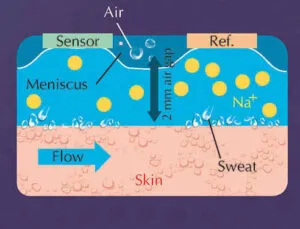Sweat sensors exist and are used to monitor electrolyte levels during exercise as a way to improve hydration.
The challenge at Waseda was to make a sweat sensor that could be put on and taken off when required – so no adhesive involved – and that would both keep working during movement, and clean itself.
It chose ion-selective membranes as the basic technology.
“Unfortunately, ion-selective membranes are inherently hydrophobic, meaning that they repel water, and by extension, sweat,” according to the university. “This leads to low signal stability and responsiveness. Additionally, body motion and friction often interfere with sensor readings, which is why most sweat sensors rely on tight contact with the skin or adhesives.”
Rose petals were the biological inspiration because they are hydrophilic (allowing droplets to stick) when exposed to small amounts of water, but turn hydrophobic (shedding water in drops and self-cleaning) once the amount of water exceeds a threshold.
Detailed study revealed two types of rose petal surface: the back-sides (referred to a fully-open rose) of petals have fine micro-wrinkles, while the front-sides have polygonal islands surrounded by wrinkles and spike-like protrusions in the center.
The team built ion-selective membranes sensors using a known structure: a highly flexible and electrically conductive mattress of carbon nano-tubes, over-laid with an ion-selective polymer based on PVC.
The upper surfaces of these were modified using micro-detail moulds taken from the two petal surfaces.
Both surfaces demonstrated significantly improved water retention in static conditions compared to conventional ion-selective membranes, said the university. Both also improved electro-chemical activity, and self-cleaned when exposed to high water levels.
The front-side petal-like surface showed highest sensitivity, but the back-side surface was chosen because it retained more water making it more resilient against motion.
 Proof-of-concept device (although ‘inlet’ and ‘outlet’ are marked, this device lays flat onto the skin)
Proof-of-concept device (although ‘inlet’ and ‘outlet’ are marked, this device lays flat onto the skin)
In a proof of concept, the researchers 3D-printed a watch-sized wearable patch with a narrow channel that held the sensing surface 2mm away from the skin, along with a silver chloride reference electrode.
Once the subject started sweating, sweat drops bridged the gap and adhered to the sensors.
“In running tests, the devices accurately monitored sodium concentrations in sweat, indicating electrolyte loss.,” said the university. “During periods of low-sweat production, the sensors retained fluid within the channels, and once sweat levels increased above a limit, they triggered the self-cleaning process. This mechanism ensures signal stability and prevents the formation of bubbles that can cause sudden signal spikes.”
Waseda University worked with Helwan University in Egypt, the Egypt-Japan University of Science and Technology in Egypt and Tokyo University Hospital.
The work is published as ‘Bioinspired microtexturing for enhanced sweat adhesion in ion-selective membranes‘ in the journal Cyborg and Bionic Systems, a Science Partner Journal.
Ed: You have to admire this team for the detail in which they studied the natural and artificial surfaces involved.

